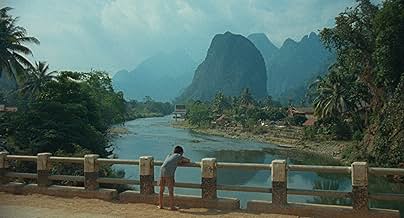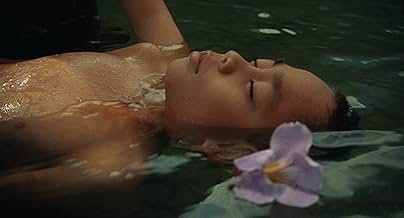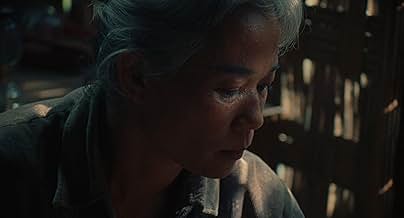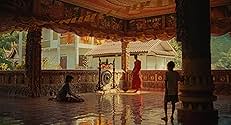अपनी भाषा में प्लॉट जोड़ेंWhen a bomb endangers the Pha Tang temple, 'Satu' an orphan child laborer decides to head north through the rich and feral landscape of Laos in search of his long lost mother with his new ph... सभी पढ़ेंWhen a bomb endangers the Pha Tang temple, 'Satu' an orphan child laborer decides to head north through the rich and feral landscape of Laos in search of his long lost mother with his new photojournalist friend 'Bo'.When a bomb endangers the Pha Tang temple, 'Satu' an orphan child laborer decides to head north through the rich and feral landscape of Laos in search of his long lost mother with his new photojournalist friend 'Bo'.
- पुरस्कार
- 2 जीत और कुल 5 नामांकन
फ़ीचर्ड समीक्षाएं
I was fortunate enough to see 'Satu: Year of the Rabbit' at the Raindance Film Festival where it was followed by a Q&A with its director, Joshua Trigg. This cinematic gem tells the story of Bo, an aspiring teenage photojournalist on the run from her abusive father, and Satu, a young orphan boy juxtapositionally embarking on a search for his estranged mother, as they journey together in the pursuit of true family.
From the film's opening scenes, we are introduced to Satu's mother and her heartbreaking realisation that she cannot provide for Satu and must relinquish his care to the monks of the Pha Tang temple. After a short time-jump where we see Satu as a young boy of eight tending to the chores of the temple, we also meet Bo a determined and compassionate young woman whose unfortunate circumstances have left her living with her abusive, alcoholic father. We see a snapshot of her suffering before she makes the decision to run away from her home and the life that she knows. Early on in Bo's journey, she encounters the Pha Tang temple. Satu, who has gone without a mother figure, is drawn to Bo's kindness and strength and Bo, sensing Satu's yearning for familial love, takes on the role of a surrogate mother with tenderness and dedication.
The cinematography following Bo and Satu through their journey is nothing short of breathtaking. The landscapes of Laos, with its beautiful natural scenery and vibrant cultural heritage are artfully captured. Each shot feels framed like a photograph, echoing Bo's photojournalistic aspirations. The film's score harmoniously blends the traditional instruments of Lao music with contemporary film scoring to complement the narrative, enhancing the emotional depth of the story; I was especially enthralled by the jaunty air playing as Bo and Satu are preparing to embark on their adventure
'Satu: Year of the Rabbit' is a film full of heart. It is a story about the families we choose and the impact we can have on each other's lives. The film does not shy away from the harsh realities of life but instead embraces them, showing that even in the face of sorrow, there is always room for love and connection.
From the film's opening scenes, we are introduced to Satu's mother and her heartbreaking realisation that she cannot provide for Satu and must relinquish his care to the monks of the Pha Tang temple. After a short time-jump where we see Satu as a young boy of eight tending to the chores of the temple, we also meet Bo a determined and compassionate young woman whose unfortunate circumstances have left her living with her abusive, alcoholic father. We see a snapshot of her suffering before she makes the decision to run away from her home and the life that she knows. Early on in Bo's journey, she encounters the Pha Tang temple. Satu, who has gone without a mother figure, is drawn to Bo's kindness and strength and Bo, sensing Satu's yearning for familial love, takes on the role of a surrogate mother with tenderness and dedication.
The cinematography following Bo and Satu through their journey is nothing short of breathtaking. The landscapes of Laos, with its beautiful natural scenery and vibrant cultural heritage are artfully captured. Each shot feels framed like a photograph, echoing Bo's photojournalistic aspirations. The film's score harmoniously blends the traditional instruments of Lao music with contemporary film scoring to complement the narrative, enhancing the emotional depth of the story; I was especially enthralled by the jaunty air playing as Bo and Satu are preparing to embark on their adventure
'Satu: Year of the Rabbit' is a film full of heart. It is a story about the families we choose and the impact we can have on each other's lives. The film does not shy away from the harsh realities of life but instead embraces them, showing that even in the face of sorrow, there is always room for love and connection.
What a lovely and heartwarming film! The cinematography is superb, with breathtaking photography and enchanting settings. I found the story captivating from start to finish, and it was deeply moving. It is a beautiful portrayal of friendship, resilience, and trust, presented in a delightful and skillful manner. I enjoyed every second of it, and it offered me a journey into a beautiful culture I was unfamiliar with, for which I now feel profound admiration and respect. The characters are well-defined and very well-acted. To me, it was worth every second. It's a film that deserves to be cherished. I love it!
A film that has truly stayed with me. What makes 'Satu - Year of the Rabbit' so special is the incredible balance it strikes between hardship and hope. Satu's journey is full of danger and heartbreak, yet there's an undeniable warmth and resilience that shines through. The bond that forms between Satu and Bo feels genuine and moving, adding a beautiful human connection to their adventure that many other 'road movies' seem to miss. Their relationship, built on trust and understanding, is the emotional heart of the film.
The cinematography is also absolutely breathtaking - the decision to shoot on 16mm film gives everything a rich, dreamlike quality. Laos itself becomes a character in the story, with its lush, untamed beauty providing a stunning backdrop to Satu's journey.
What also stands out is the film's commitment to showcasing local talent. The performances are natural and heartfelt, especially from the young actor playing Satu, who brings so much depth and authenticity to the role. You can feel the care and respect that went into portraying this story, making it clear how much love the director and writer of teh film Joshua Trigg had for the culture and the people.
Trigg has crafted something truly remarkable here, and I can't recommend this film enough. It's heartfelt, visually stunning, and deeply moving - a must-see for anyone who loves thoughtful, beautifully told stories.
The cinematography is also absolutely breathtaking - the decision to shoot on 16mm film gives everything a rich, dreamlike quality. Laos itself becomes a character in the story, with its lush, untamed beauty providing a stunning backdrop to Satu's journey.
What also stands out is the film's commitment to showcasing local talent. The performances are natural and heartfelt, especially from the young actor playing Satu, who brings so much depth and authenticity to the role. You can feel the care and respect that went into portraying this story, making it clear how much love the director and writer of teh film Joshua Trigg had for the culture and the people.
Trigg has crafted something truly remarkable here, and I can't recommend this film enough. It's heartfelt, visually stunning, and deeply moving - a must-see for anyone who loves thoughtful, beautifully told stories.
Satu is a brilliant independent film, oozing with charm and a love letter to both the people and the films geographical setting of Laos. Between the cinematography and the unfolding story that asks the viewer to explore their own questions that transpire when you watch this piece of cinema. I thoroughly enjoyed my watch. It's definitely deserving of the runtime and I'd thoroughly recommend to anyone who still appreciates genuine filmmaking done for the true love and passion of the craft. The 16mm medium once again shows it beauty and capacity to render shots in the most arresting of ways. Give it a watch.
A visually stunning film with a beautiful plot line. If you are looking for your next film to watch, you have come across a gem.
The film manages to capture the landscape of Laos like I have never seen before - I went to visit it a long time ago and revisiting parts of this country through this film brought me back to some beautiful memories of the days I spent there.
I went to see this film at the annual Raindance Film festival in London recently with a packed cinema. There was an interesting Q&A with the director that shared some of anecdotes of creating this film that felt authentic and insightful to say the least. This film showcases what independent cinema to its finest!
The film manages to capture the landscape of Laos like I have never seen before - I went to visit it a long time ago and revisiting parts of this country through this film brought me back to some beautiful memories of the days I spent there.
I went to see this film at the annual Raindance Film festival in London recently with a packed cinema. There was an interesting Q&A with the director that shared some of anecdotes of creating this film that felt authentic and insightful to say the least. This film showcases what independent cinema to its finest!
टॉप पसंद
रेटिंग देने के लिए साइन-इन करें और वैयक्तिकृत सुझावों के लिए वॉचलिस्ट करें
विवरण
- चलने की अवधि1 घंटा 33 मिनट
- रंग
- पक्ष अनुपात
- 1.85 : 1
इस पेज में योगदान दें
किसी बदलाव का सुझाव दें या अनुपलब्ध कॉन्टेंट जोड़ें

टॉप गैप
By what name was Satu - Year of the Rabbit (2024) officially released in Canada in English?
जवाब
















